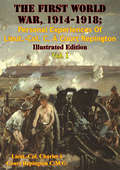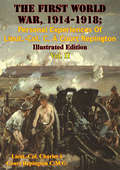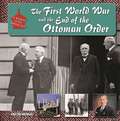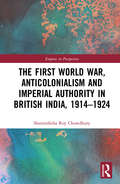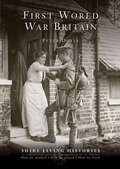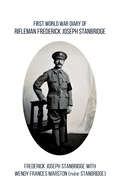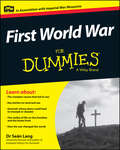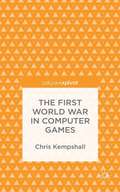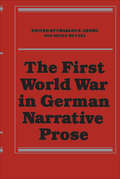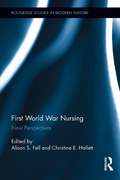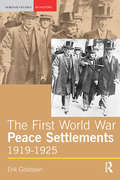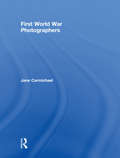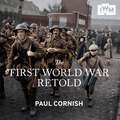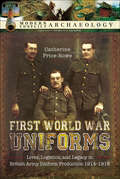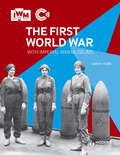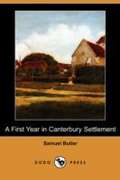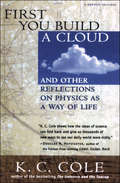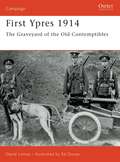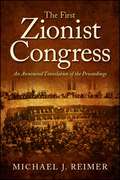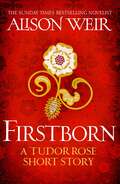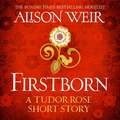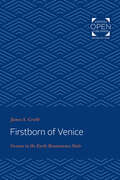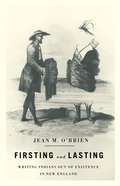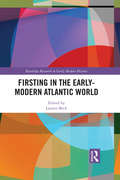- Table View
- List View
The First World War, 1914-1918; Personal Experiences Of Lieut.-Col. C. À Court Repington Vol. I [Illustrated Edition] (The First World War, 1914-1918; Personal Experiences Of Lieut.-Col. C. À Court Repington #1)
by Lieut.-Col. Charles à Court Repington C.M.G.Includes the First World War Illustrations Pack - 73 battle plans and diagrams and 198 photosA fascinating history of the First World War seen through the eyes of a highly respected and connected War Correspondent.Lieut.-Col. Charles à Court Repington was a career soldier in the British Army; renowned for his service in the Sudan, Burma and the Boer War, he was drummed out of the service for having an affair with the wife of British official in 1902. He was well known as an excellent staff officer and remained closely tied to the comrades that he had fought and served with including the future leaders of the British Army in the First World War. Cutting his teeth as a war correspondent during the Russo-Japanese War of 1904-1905, he was ideally placed as the War Correspondent of the Times when war broke out in 1914 to report on the unfolding tragedy. Using all of his connections and influence he visited the Western Front many times and was in intimate correspondence and contact with the senior figures of the British Army such as Sir John French, Sir Douglas Haig, Herbert Plumer and Horace Smith-Dorrien. No great respecter of private conversations or confidences he lost many friends when he wrote The First World War; his work was critical, well-written, caustic and unbiassed.These classic memoirs remain as valuable and vivid as they when they were written. This first volume covers the outbreak of the war to early 1917.
The First World War, 1914-1918; Personal Experiences Of Lieut.-Col. C. À Court Repington Vol. II [Illustrated Edition] (The First World War, 1914-1918; Personal Experiences Of Lieut.-Col. C. À Court Repington #2)
by Lieut.-Col. Charles à Court Repington C.M.G.Includes the First World War Illustrations Pack - 73 battle plans and diagrams and 198 photosA fascinating history of the First World War seen through the eyes of a highly respected and connected War Correspondent.Lieut.-Col. Charles à Court Repington was a career soldier in the British Army; renowned for his service in the Sudan, Burma and the Boer War, he was drummed out of the service for having an affair with the wife of British official in 1902. He was well known as an excellent staff officer and remained closely tied to the comrades that he had fought and served with including the future leaders of the British Army in the First World War. Cutting his teeth as a war correspondent during the Russo-Japanese War of 1904-1905, he was ideally placed as the War Correspondent of the Times when war broke out in 1914 to report on the unfolding tragedy. Using all of his connections and influence he visited the Western Front many times and was in intimate correspondence and contact with the senior figures of the British Army such as Sir John French, Sir Douglas Haig, Herbert Plumer and Horace Smith-Dorrien. No great respecter of private conversations or confidences he lost many friends when he wrote The First World War; his work was critical, well-written, caustic and unbiassed.These classic memoirs remain as valuable and vivid as they when they were written. This second volume covers the period from spring 1917 until the end of the war.
The First World War and the End of the Ottoman Order
by Kristine BrennanThe First World War and the End of the Ottoman Order examines the social and political events of the 19th and early 20th centuries that brought the Ottomans into the First World War on the side of the Central Powers, discusses the division of the empire at the 1919 Paris Peace Conference, and explains the formation of modern Turkey.
The First World War, Anticolonialism and Imperial Authority in British India, 1914-1924 (Empires in Perspective)
by Sharmishtha Roy ChowdhuryBetween 1914, when the Great War began, and 1924, when the Ottoman Caliphate ended, British and Indian officials and activists reformulated political ideas in the context of total war in the Middle East, Gandhian mass mobilisation, and the 1919 Amritsar massacre. Using discussions on travel, spatiality, and landscape as an entry point, The First World War, Anticolonialism and Imperial Authority in British India, 1914–1924 discusses the complex politics of late colonial India and the waning of imperial enthusiasm. This book presents a multifaceted picture of Indian politics at a time when total war and resurgent anticolonial activism were reshaping assumptions about state power, culture, and resistance.
First World War Britain
by Peter DoyleWhen Britain declared war on Germany in August 1914, most expected the war to be over by Christmas, and only a handful forecast the length of the conflict, or the impact it would have on a civilian population whose experience of war to date had been reading of the exploits of the British Army in distant Sudan or South Africa. The First World War would change British society, often irrevocably and sometimes for the better, but it also brought hardship and fear. Rationing, government restrictions, censorship, and bombardment from both the sea and air, meant that for the first time, civilians found themselves part and sometimes victims, of 'total war'. Shopkeepers might boast that it was business as usual, but nobody could ignore the social upheaval, the restrictions introduced by new legislation or the strains and privations facing day-to-day existence. Nonetheless, the war also saw Britain galvanise itself in a collective effort to increase industrial productivity, domestic self-sufficiency and reduce waste - all key factors in helping to win the war. Lucinda Gosling explores how the people left at home adapted their lifestyles to meet the challenges of the time, looking at the minutiae of everyday life such as rationing-influenced recipes and popular toys, alongside broader issues like food shortages and industrial unrest.
First World War Diary of Rifleman Frederick Joseph Stanbridge
by Frederick Joseph StanbridgeSomewhere in Palestine March 10th, 1918 My Very Dear Brother Ern, ….since receiving your last letter, I have been "over the top". I was expecting to have to go, but I assure you Ern, I never dreamed it would be so terrible!… I want to try to forget those certain 16 hours, but I cannot, and I am afraid I never shall. I really think the night of February 19-20th was (for me anyhow) a night in hell. We had to attack Johnny with the bayonet in the dark about 1:30 (and it was dark too). He was stronger than expected. If our machine guns had not come up just in time, I think we would all have been wiped out.
First World War For Dummies
by Seán LangFrom the Somme to Gallipoli to the home front, First World War For Dummies provides an authoritative, accessible, and engaging introduction to the War to End All Wars. It takes a global perspective of this global conflict, proving insight into the actions and motivations of the participants and how each nation’s story fits into the wider one. Coverage also includes: The origins of the war and a snapshot of what the world looked like at the beginning of the 20th century The battles of Western Europe, and action in the Southern and Eastern Fronts The war at home — the civilian war, propaganda, opposition, politics, protests, and more 1918: The German spring offensive, the Allied success and the beginning of the end The Treaty of Versailles, the League of Nations, and the effect on the future First World War For Dummies is the go-to source for readers seeking to learn more about the fundamental event of the 20th century.
The First World War in Computer Games
by Chris KempshallThe First World War in Computer Games analyses the depiction of combat, the landscape of the trenches, and concepts of how the war ended through computer games. This book explores how computer games are at the forefront of new representations of the First World War.
The First World War in German Narrative Prose
by Charles N. Genno Heinz WetzelThis collection of eight essays in honour of the distinguished Canadian Germanist G.W. Field treats themes in German narrative prose of the First World War, the pre-war era, and the earliest of the Weimar Republic. The aim of the book is not to present a comprehensive study of the field, but rather to shed new light on specific problems. The essays are organized in the historical sequence of the events and situations to which they are related. The topics include discussions of the concept of war as presented by Robert Musil in Der Mann hone Eigenschaften; the treatment of war as a catalyst by the Expressionist writers Carl Sternheim and Leonhard Frank; the preservation of values in the face of war as dealt in Hesse's Demian; and an exploration of the effects of war on the individual and social values in the works of Salomo Friedländer and Alfred Döblin. An essay on H.G. Well's Mr. Britling Sees It Through helps to clarify the ways in which the reaction of German writers to the war may be viewed as specifically German by providing an outsider's point of view. The final chapter, a survey of the most recent literature on the topic, shows how much World War I lives on in the minds of German writers as the great turning point in German political and cultural history.
First World War Nursing: New Perspectives (Routledge Studies in Modern History #11)
by Christine E. Hallett Alison S. FellThis book brings together a collection of works by scholars who have produced some of the most innovative and influential work on the topic of First World War nursing in the last ten years. The contributors employ an interdisciplinary collaborative approach that takes into account multiple facets of Allied wartime nursing: historical contexts (history of the profession, recruitment, teaching, different national socio-political contexts), popular cultural stereotypes (in propaganda, popular culture) and longstanding gender norms (woman-as-nurturer). They draw on a wide range of hitherto neglected historical sources, including diaries, novels, letters and material culture. The result is a fully-rounded new study of nurses’ unique and compelling perspectives on the unprecedented experiences of the First World War.
The First World War Peace Settlements, 1919-1925 (Seminar Studies)
by Erik GoldsteinThe First World War changed the face of Europe - two empires (the Austro-Hungarian Empire and the Ottoman Empire) collapsed in its wake and as a result many of the boundaries of Europe were redrawn and new states were created. The origins of many of the international crises in the late twentieth century can be traced back to decisions taken in these critical years, Yugoslavia being the most obvious example. An understanding of the peace settlements is thus crucial for any student studying international history/international relations, which is what this book offers.This book provides and accessible and concise introduction to this most important period of history.
First World War Photographers
by Jane CarmichaelFirst Published in 1989. Routledge is an imprint of Taylor & Francis, an informa company.
The First World War Retold
by Paul CornishIWM was founded on 5 March 1917 when the War Cabinet approved a proposal by Sir Alfred Mond MP for the creation of a national war museum to record the events still taking place during the First World War. The intention was to collect and display material as a record of everyone's experiences during the war - civilian and military - and to commemorate the sacrifices of all sections of society.The First World War Retold tells the story of that war from a fresh perspective from IWM's unparalleled collections. It presents events as they happened, through quotations from diaries, letters or reported conversations written or spoken within hours, days or weeks of the events they describe. Through these voices and objects - emotive, immediate, and sometimes surprising - the story of the war is retold from a compelling new angle, allowing us to both understand and reflect upon the landmark conflict that still shapes our lives today.(P)2021 Headline Publishing Group Limited
First World War Uniforms: Lives, Logistics, and Legacy in British Army Uniform Production, 1914–1918 (Modern Conflict Archaeology)
by Catherine Price-RoweView any image of a Tommy and his uniform becomes an assumed item, few would consider where and how that uniform was made. Over 5 million men served on the Western Front, they all required clothing. From August 1914 to March 1919, across all theaters of operations, over 28 million pairs of trousers and c.360 million yards of various cloth was manufactured.Worn by men of all ranks the uniform created an identity for the fighting forces, distinguished friend from foe, gave the enlisted man respect, a sense of unity whilst at the same time stripping away his identity, turning a civilian into a soldier. Men lived, worked, slept, fought and died in their uniform.Using the authors great-grandfather's war service as a backdrop, this book will uncover the textile industries and home front call to arms, the supply chain, salvage and repair workshops in France, and how soldiers maintained their uniform on the front line.Items of a soldiers uniform can become a way to remember and are often cherished by families, creating a tangible physical link with the past, but the durability of cloth to withstand time can create an important legacy. The fallen are still discovered today and remnants of uniform can help to identify them, at the very least the color of cloth or type of hob nail can give the individual his nationality allowing them to be given a final resting place.
The First World War with Imperial War Museums: With Imperial War Museums
by Sarah WebbBring the First World War to life with a fresh interpretation of the War, combining the expertise of IWM and Hodder Education in both the First World War and educational publishing. This Student's Book and accompanying Dynamic Learning resource provide a discrete unit of study. Together, they present new stories, sources and teaching tools which allow learners to explore the conflict and the experiences of those involved in the fighting and on the home front. - Follow the lives of individuals and focus on artefacts from IWM's collections - Enable learners to investigate the War through a range of rich IWM resources including photos, letters and other evidence, and learn why the First World War shaped the lives of British people more than any other - Ideal for GCSE lessons, too
The First World War with Imperial War Museums: With Imperial War Museums
by Sarah WebbBring the First World War to life with a fresh interpretation of the War, combining the expertise of IWM and Hodder Education in both the First World War and educational publishing.This Student's Book and accompanying Dynamic Learning resource provide a discrete unit of study. Together, they present new stories, sources and teaching tools which allow learners to explore the conflict and the experiences of those involved in the fighting and on the home front.- Follow the lives of individuals and focus on artefacts from IWM's collections- Enable learners to investigate the War through a range of rich IWM resources including photos, letters and other evidence, and learn why the First World War shaped the lives of British people more than any other- Ideal for GCSE lessons, too
A First Year in Canterbury Settlement
by Samuel ButlerA First Year in Canterbury Settlement, the earliest book by Butler, is a beautifully narrated tale of a colonial settler. <P> <P> Through journal of the author as a young emigrant, we get a first-hand account of his sea voyage to New Zealand. The vibrant descriptions of flora and fauna of the new land show his keen interest in everything, from exploration of the terrain to sheep-farming. Informative!
First You Build a Cloud: And Other Reflections on Physics as a Way of Life
by K. C. ColeThis clearly written and compelling look at physics and physicists offers &“thousands of new ways to see our daily world more richly&” (Douglas Hofstadter, author of Gödel, Escher, Bach). For many of us, physics has always been a thing of mystery and complexity. K. C. Cole, an award-winning science writer, specializes in making its wonders accessible to the everyday reader. This book uses lively prose, metaphors, and anecdotes to allow us to comprehend the nuances of physics: gravity and light, color and shape, quarks and quasars, particles and stars, force and strength. It also shows us how the physical world is so deeply intertwined with the ways we think about culture, poetry, and philosophy, and explores the workings of such legendary scientific minds as Richard Feynman, Victor Weisskopf, brothers Frank Oppenheimer and J. Robert Oppenheimer, Philip Morrison, Vera Kistiakowsky, and Stephen Jay Gould. &“An exemplary science writer . . . For readers without scientific background, Cole gracefully introduces relativity, quantum theory, optics, astrophysics, and other significant disciplines, never getting bogged down in unnecessary explanation. Thus, you may not learn all about thermodynamics from reading her chapter on it, but you will learn enough to think seriously about the entropy in your own life. Cole sprinkles her text with comments from famous scientists—&‘Space is blue, and birds fly in it,&’ said Heisenberg, and Faraday said, &‘Nothing is too wonderful to be true&’—that are not only delightful in themselves but perfectly suited to her own text. No review of Cole&’s book could be too wonderful to be true.&” —Booklist
First Ypres 1914
by Ed Dovey David LomasOsprey's overview of the First Battle of Ypres of World War I (1914-1918). In the autumn of 1914 the original British Expeditionary Force faced a heavily reinforced German drive. Field Marshal Sir John French, the British Commander-in-Chief, had sent his men north in an attempt to take the fight into Flanders, so they could fight across open ground. History tells us that this was not to be the case. David Lomas chronicles the first of the trench-warfare battles, where lines that would remain almost static for the rest of the war were established. Although the Germans failed to reach the channel ports, the death knell had rung for the BEF, which was virtually wiped out in this brave defence.
The First Zionist Congress: An Annotated Translation of the Proceedings
by Michael J. ReimerFinalist for the 2019 Foreword INDIES Book of the Year Award in the History categoryThe First Zionist Congress, held in Basel, Switzerland, in August 1897, was arguably the most significant Jewish assembly since antiquity. Its delegates surveyed the situation of Jews at the end of the nineteenth century, analyzed cultural and economic issues facing them, defined the program of Zionism, created an organization for planning and decision-making, and coalesced in camaraderie and shared aspiration. Though Zionism experienced multiple conflicts and reversals, the Congress's goal was ultimately realized in the establishment of Jewish sovereignty in Palestine—the State of Israel—in 1948. As Theodor Herzl, the Congress's principal organizer, declared: "At Basel I founded the Jewish state."This volume presents, for the first time, a complete translation of the German proceedings into English. Michael J. Reimer's accessible translation includes explanatory annotations and a glossary of key terms, events, and personalities. A detailed introduction situates the First Zionist Congress in historical context and provides a summary of each day's events. The Congress's debates supply a case study in the history of nationalism: they feature imagery and tropes used by nationalists all over Europe, while appealing to the distinctive heritage of Judaism. The proceedings are also important for what they say—and omit—about the Ottoman state that ruled Palestine as well as the Palestinian Arab people living there. This is a foundational primary source in modern Jewish history.
Firstborn: A Tudor Rose short story
by Alison WeirFROM THE SUNDAY TIMES-BESTSELLING AUTHOR OF THE SIX TUDOR QUEENS SERIES.In this short prequel to Alison Weir's new novel, Elizabeth of York, The Last White Rose, the young princess is born - and the future of England hangs in the balance.The Palace of Westminster, 1466. As the Queen of England lies in her chamber, exhausted from childbirth, the court awaits news of the longed-for heir...The KingEdward prays for a son to ensure the succession of his line.The godfatherWarwick knows his influence over the King cannot last.The grandmotherCecily hopes her new grandchild will one day bring great fortune to England.The friendLord Hastings fears the growing hostility within King Edward's inner circle.The young rivalThe boy Henry does not yet know his own significance.The uncleRichard visits the new baby - and dreams that night of a golden crown.**Includes a preview of the spellbinding first novel in the Tudor Rose trilogy - Elizabeth of York, The Last White Rose**
Firstborn: A Tudor Rose short story
by Alison WeirFROM THE SUNDAY TIMES-BESTSELLING AUTHOR OF THE SIX TUDOR QUEENS SERIES.In this short prequel to Alison Weir's new novel, Elizabeth of York, The Last White Rose, the young princess is born - and the future of England hangs in the balance.The Palace of Westminster, 1466. As the Queen of England lies in her chamber, exhausted from childbirth, the court awaits news of the longed-for heir...The KingEdward prays for a son to ensure the succession of his line.The godfatherWarwick knows his influence over the King cannot last.The grandmotherCecily hopes her new grandchild will one day bring great fortune to England.The friendLord Hastings fears the growing hostility within King Edward's inner circle.The young rivalThe boy Henry does not yet know his own significance.The uncleRichard visits the new baby - and dreams that night of a golden crown.**Includes a preview of the spellbinding first novel in the Tudor Rose trilogy - Elizabeth of York, The Last White Rose**(P) 2022 Headline Publishing Group Ltd
Firstborn of Venice: Vicenza in the Early Renaissance State (The Johns Hopkins University Studies in Historical and Political Science #106)
by James S. GrubbSelected by Choice Magazine as an Outstanding Academic TitleOriginally published in 1988. In the decades after 1404, traditionally maritime Venice extended its control over much of northern Italy. Citizens of Vicenza, the first city to come under Venetian rule, proclaimed their city "firstborn of Venice" and a model for the Venetian Republic's dominions on the terraferma. In Firstborn of Venice James Grubb tests commonplace attributes of the Renaissance state through a rich case study of society and politics in fifteenth-century Vicenza. Looking at relations between Venetian and local governments and at the location of power in Vicentine society, Grubb reveals the structural limitations of Venetian authority and the mechanisms by which local patricians deflected the claims of the capital. Firstborn of Venice explores issues that are political in the broadest sense: legal institutions and administrative practices, fiscal politics, the consolidation of elites, ecclesiastical management, and the contrasting governing ideologies of ruler and subjects.
Firsting and Lasting: Writing Indians out of Existence in New England (Indigenous Americas Series)
by Jean M. O'BrienIn Firsting and Lasting, Jean M. O’Brien argues that local histories became a primary means by which European Americans asserted their own modernity while denying it to Indian peoples. Erasing and then memorializing Indian peoples also served a more pragmatic colonial goal: refuting Indian claims to land and rights. Drawing on more than six hundred local histories from Massachusetts, Connecticut, and Rhode Island written between 1820 and 1880, as well as censuses, monuments, and accounts of historical pageants and commemorations, O’Brien explores how these narratives inculcated the myth of Indian extinction, a myth that has stubbornly remained in the American consciousness.
Firsting in the Early-Modern Atlantic World
by Lauren BeckFor centuries, historians have narrated the arrival of Europeans using terminology (discovery, invasion, conquest, and colonization) that emphasizes their agency and disempowers that of Native Americans. This book explores firsting, a discourse that privileges European and settler-colonial presence, movements, knowledges, and experiences as a technology of colonization in the early modern Atlantic world, 1492-1900. It exposes how textual culture has ensured that Euro-settlers dominate Native Americans, while detailing misrepresentations of Indigenous peoples as unmodern and proposing how the western world can be un-firsted in scholarship on this time and place.
